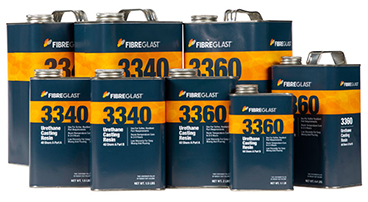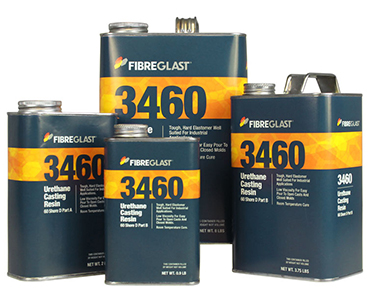Introduction
Casting urethanes are versatile materials that can be used alone, with one another, or even with composites. From flexible molds to durable, impact-resistant parts, our selection of urethanes provides a wide range of properties for a variety of uses.
Watch the video for a brief look at the different properties of Shore A and Shore D casting urethanes from Fibre Glast. For more information on the Shore Durometer scale, check out the Introduction to Urethane Casting Resins white paper. For a general how-to guide for casting, read the Step-by-Step Guide to Fast Set Urethane Resins.
Shore A Urethanes as Molds

Our selection of Shore A Urethanes can be used as flexible materials to create molds with negative angles. Unlike composite molds which cannot release parts with negative angles, the soft, pliable Shore A urethane can be bent back (or even cut off) for easier release. If cast in thick sections, the pliable urethanes retain enough dimensional stability to mold composite parts. Building molds with the Shore A urethanes saves significant labor and time versus building small composite molds. As molds get larger, however, fabricators choose composites for their weight, longevity, and cost efficiencies.
Tech Tips
| When drilling a softer urethane, such as the 40A or 60A, use a larger bit than you would like the final hole to be. Drilled holes in soft urethanes will be smaller than the bit used. |
| The Shore A urethanes have a de-mold time of 2.5 to 3 hours, depending on the part size, temperature of materials, and conditions of the ambient environment. They can completely cure at room temperature. They can be cast in urethane molds, as well as composite molds created with polyester and epoxy resins. The 40A and 60A have exceptionally low shrinkage, as well—less than 1/1,000 of an inch per inch of material. |
Shore D Urethanes as Molds

As a casting material, the 60 Shore D urethane is an extremely durable finished material. It has high impact and abrasion resistance, with high tear strength and elongation properties. With a de-mold time of 2.5–3 hours, parts can be cycled in and out of molds quickly, with parts reaching their maximum properties in 7 days. The material's ruggedness makes it ideal for casting long-lasting, oil-resistant parts for industrial equipment, such as as bushings and seals. The durable urethane may also be overmolded as wheels or rollers.
The 75D, with a 1:1 mix ratio by weight, casts a bright white, extremely durable part or prototype, with the hardness similar to HDPE plastic. It has a low mixed viscosity, which allows it to fill molds quickly and to replicate complicated details for extremely detailed parts. Its low viscosity, similar to motor oil, even allows hand injection of fine details. It can be cast as a prototype in composite molds, or cast in molds created with other urethanes to create high-performance parts with extremely smooth and dense surfaces.
The 75D has a longer pot life (30 to 40 minutes) than the other Shore A and D urethanes, and a slightly longer de-mold time of 3 to 4 hours. The part may be put into service in 18 to 24 hours, with full cure in 7 days. It cures completely at room temperature.
Shore D urethanes are more impact-resistant than composite parts and exhibit omnidirectional strength, as opposed to composites' directional strength based on fiber orientation. With a faster de-mold time than composites, urethane parts can be produced more quickly out of a limited number of molds. Reinforced composite parts have higher tensile strengths and better strength-to-weight properties.
Tech Tips
| Heat can be used to accelerate the final cure of urethanes, but, in general, the more heat applied, the greater the final casting shrinkage. Allow for 18 hours of curing at room temperature before a post-cure to minimize shrinkage. |
Urethanes vs. Composites in Molds
When deciding between urethanes and fiber-reinforced plastics to create molds, there are five main factors to consider:
Cost - Urethane molds are more expensive than common molds made from fiberglass and polyester resin. For large-scale projects, composite molds make the most sense.
Speed of mold production - Compared to composite molds, urethane molds may be quicker to cast, with less active working time.
Finish surface appearance - Urethane molds will not provide Class A finishes directly out of the mold that well-prepared polyester composite molds can.
Mold complexity - Urethanes are able to pick up very fine details in plugs easier than composites. They are less brittle in unreinforced sections than polyester-resin composites. Urethane molds are pliable, and generally make it easier to release parts by warping and bending.
Number of parts needed - If cared for properly, composite molds can cast parts for a very long time, while urethane molds degrade with exotherm from the curing process. Over-catalyzed polyester parts can accelerate degradation..
Urethane Product Pages
When shopping for Urethanes, it is important to consider the needs of your project. Urethane shore types behave differently, and your selection will need to be decided based on the required characteristics of the finished part. Take a look at the product pages listed below, as well as the product data sheets for each of the casting resins Fibre Glast carries.
| Item |
Description |
|
| Shore A Urethane Resins |
The Shore A 40 and 60 urethanes make it easy to create either softer or more resilient parts and tooling. Remember to pour the urethane slowly when using, in order to release any potential air bubbles within the resin. |

|
| Urethane Casting Resin 60 Shore D |
Extremely tough, this resin is well suited for demanding industrial applications. 60 shore D exhibits high tensile and tear strength, excellent elongation and good abrasion resistance. |

|
| Urethane Casting Resin 75 Shore D |
For final parts and short-run casting, the 75 Shore D can create detailed parts with superior cosmetic qualities. It's simple mixing ratio and low mixed viscosity make it an ideal material to fill complicated molds. |

|
Release Agents
Release agents should be selected on the basis of the part being made rather than the mold material. When producing polyester, vinyl ester, or epoxy parts, mold release agents such as the classic wax and PVA system may be used. They are water based, however, and cannot be used when producing urethane parts. Water-based mold releases can cause bubbling or pitting on the surface against the mold. When casting urethane parts, use mold releases specifically formulated for urethanes.
Tech Tips
| For best results, mix urethanes in two different cups. After combining Parts A and B of the urethane, mix them initially, then transfer the mixture into another container and continue mixing. Mixing in two different cups decreases the chance that unmixed substances make it to the mold, and helps avoid weak or uncured spots in the cast. Factor in 10 to 15% of extra material per part to make up for residue left in the mixing containers. |
Release Agent Product Pages
Remember, when working with urethanes, moisture can seriously harm your finish products. Specially formulated release agents must be used, that are designed to be used with uethane resins.
| Item |
Description |
|
| Easy Clean Mold Release |
Easy Clean Mold Release allows for easy separation of urethane resins from epoxy or metal tooling production applications. Simply brush, spray or wipe it on to prepare the mold. We recommend three to five layers, waiting a few minutes in between each. |

|
| Non-Silicone High Temp Paste Wax |
Non-Silicone High Temp Paste wax works great as a release for your urethane castings, and is able to be used at temperature ranges from 75°F to 375°F. It is recommended that you use five layers for your casting process. |

|
Limitations of Urethanes
Urethanes are extremely sensitive to moisture contamination; even humid ambient environments can affect the cure cycle and surface quality by creating air bubbles on the surface and voids on the interior. Use plastic or metal stir sticks and containers when mixing and casting urethanes. Wooden stir sticks and paper containers may contaminate urethanes with moisture absorbed from the air, and, if scratched, wax-lined containers may leave bits of wax in the mixture.
Unreinforced urethanes have lower tensile strengths than composites, though the tensile strengths of the Shore D urethanes (6,014 psi for 60D and 5,000 for 75D) are capable for many applications. The Shore A urethanes (800 for 40A and 1,400 for 40D) have extremely low tensile strengths compared to composites and Shore D urethanes.
